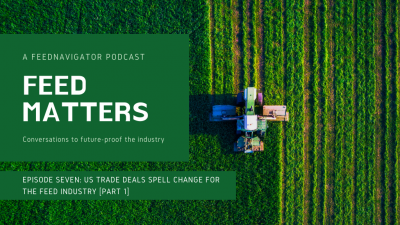2018 in review: US feed production, trade, regulation

Leah Wilkinson, vice president of public policy and education with the American Feed Industry Association (AFIA), said 2018 started on a positive note for the feed production industry, with regulatory reform one of the top agenda items of the Trump administration.
The ongoing rollout of the Food Safety Modernization Act (FSMA) meant there were some questions about what regulatory reform might mean for the feed industry, she told us.
“The opportunity to continue along that path of reshaping or refocusing some of those regulations – that’s where we started. We were looking towards potential revisions, but it became clear that that wasn’t going to happen. So then we focused our attention on the guidance documents [relating to FDA preventive controls and foreign supplier verification] and making sure they were appropriate for our industry.
“They’re still rolling out a lot of that information to the industry, and to their own inspectors.”
The AFIA has been translating the content of those guidance documents into a form that is understandable for feed manufacturers, she said.
The association is also helping its members prepare for upcoming inspections.
The FDA is carrying out CGMP inspections incrementally at US feed producers of different sizes: “Every size facility - large, small, [and] very small - has to be complaint with the current good manufacturing practices (CGMPs). Phase-in continues with the preventive controls side.”
Smaller facilities will not see inspections start until next year, she added. That timetable gives them a year to develop a process before they are inspected.
The industry continues to learn from the ongoing current good manufacturing practice inspections, she said. “We’ll be continuing to glean information as we can – continuing to talk to the FDA as we get feedback from how inspections are going, and provide that counsel to our members,” she added.
In addition to helping facilities stay compliant, the AFIA wants to remind producers of what their rights are during an inspection and what rights and authority an inspector has, she said.
Trade
Given the developments over the year and the impact of political decisions, the AFIA also has been focusing its efforts on trade.
“The tariff situation specifically with China has been one that has caused the industry concern.
“We had a big focus on China and going through their decree 118 process to get our facilities audited so we could keep and expand that potential market for our different categories – feed additives or pet food areas.
“The uncertainty that came with all the tariffs, that really put all that work on standstill for us.”
Thus, the AFIA, she said, has also been working to diversify potential markets for its members,
“We’re optimistic about the agreement with US Mexico and Canada,” she said. “Since NAFTA came into being we tripled our animal food exports to those two countries – we went from $669m in 1993 to $3.1bn in that trade. We’re happy that the market continues and that the zero tariffs are there.”
US Grains Council push
From a trade perspective, the year has been somewhat “torturous” said Tom Sleight, president and CEO of the US Grains Council.
However, there have been strong export levels for certain feed grains, chiefly corn and barley, he said. Export of dried distillers grains with solubles (DDGS) have also been good.
There were challenges, though, in relation to sorghum trade to China, he said.
“Most of the last year, we were wrapped up in [the US, Mexico and Canada trade deal] USMCA,” he said. “That had a lot of ebbs and flows, but there was momentum.”
Meanwhile, he said the council is keeping an watchful eye on all reports of China’s recent purchases of soybeans.
Looking at trade efforts outside of China, there have been some positive developments in relation to efforts throughout Southeast Asia including in Myanmar, Cambodia and Indonesia, said Sleight. There also has been progress made through working with chicken producers in North Africa and with the ruminant sector in the Middle East.
“We had a lot of creative people working around the world,” he said.
US farm economy
On the feed crop production, 2018 is ending with questions of liquidity as producers face concerns from low commodity prices, the potential for input costs to increase and the understanding that there will not be another series of support payments in 2019, said David Widmar, agricultural economist.
“We’re getting into a tough spot with the farm economy,” he told us.
More debt is be added to the farm economy, and if too much is added then there start to be questions of solvency – which some farms faced in the 1980s, he said.
“We haven’t seen net farm income drop to where it was in the 1980s – but we’re concerned out the duration of low net farm income as this has been trending sideways for a few years now,” he said. “It’s been a drip, drip, drip and the erosion of the financial position is not a good story for agriculture.”
At the start of 2018, the farm economy had been in an oversupply situation following several years of expanded production and high yields, he said.
“Wheat was the carney in the coal mine and it was starting to improve, so we saw that the oversupply issue was starting to resolve itself and now we move to demand,” said Widmar. “What is China going to be buying? And what are our other partners going to be buying?”
Although there was some initial optimism based on the strength of demand for feed grains, that may be starting to fade, he said.
“There is hope and optimism that there will be upsides to the demand story and there will be positives to agriculture from all of this, but the economic realities of that – the downsides on the short term are coming home,” he said. “We’re seeing commodity prices fall, seeing the challenges of a trade war are starting to hit home on the farm this year so producers have optimism that the demand story, that it is a long-term story, that there will be some positive resolution to that, but we’re facing economic realities that are coming home this fall.”












